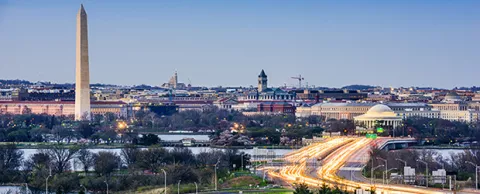
The Council is excited to return to Washington, D.C., September 27-29 for the second-annual Smart Cities Week. Check out the program grid and make plans to attend.
As we lead up to Smart Cities Week, I’ve asked our host city to share the work it’s doing and the lessons it has learned so far on its smart cities journey. Below, you’ll read about digital services are playing key roles and delivering results. — Jesse Berst
By Scott Pomeroy, Rimas Gulbinas, Geoff Mulligan and John Teeter
The District government is making significant strides to become a smarter and more connected city. One of the first and most significant steps in this process was the creation of the SmarterDC Tiger Team made up of District agencies (transportation, public safety, health care, economic development, urban planning, education, environmental, building management and public utilities) along with other key stakeholders including federal government, universities, Business Improvement Districts (BIDs) and the technology community.
SmarterDC has initiated a number of smart city pilot projects that will help shape future frameworks for interoperability, scalability and cyber resiliency. It has also created a public Web portal, smarter.dc.gov, to aid transparency and collaboration across all interested communities—government, academia, citizens and industry.
A key factor that distinguishes the District of Columbia from many cities in the U.S. is its expansive city-owned and managed data transport network that provides services to government agencies and many health, education and community anchor institutions across the city. Through the Office of the Chief Technology Officer (OCTO), this government-owned and operated network provides high bandwidth applications and capabilities in an end-to-end ultra-high capacity network environment.
With this high speed capability, this government-owned network connects government agencies, community anchors, research and development institutions and other partners to national initiatives to include the Global Environment for Network Innovation (GENI) network and the Internet2 through the newly announced Capital Area Advanced Research and Education Network (CAAREN).
The DowntownDC Business Improvement District is actively engaging with OCTO to identify future partnership opportunities around these smart city initiatives.
OCTO’s network also provides free public Wi-Fi at over 680 hotspot locations throughout the city with plans to upgrade this service to Gigabit Wi-Fi by late 2017. Additionally, through the DC Community Access Network (DC-CAN) provides affordable, value-added broadband services to over 250 health, education, public safety and other community anchor institutions with a focus on broadband in the underserved areas of the District.
The DowntownDC BID is currently deploying information kiosks in public space throughout the BID footprint. Each of the proposed kiosks has the ability to provide Wi-Fi access as well as other platforms for experimentation with IoT sensor base technologies.
In addition, through private partnerships between DowntownDC BID, Senet and Maalka, a deployment of a LoRa sensor network will extend the capabilities of both city and MetroLab to provide data and analytics to further the value to communities within the District. And, through collaboration with national partners, share the lessons learned and best practices for community owned communications infrastructure with the nation.
Scott Pomeroy is Director of Sustainability Initiatives, DowntownDC Business Improvement District. Rimas Gulbinas is CEO of Maalka. Geoff Mulligan is Chairman of LoRa Alliance. John Teeter is CIO of Urban.Systems and Chairman of Maalka.
Smart Cities Readiness Guide ….
Use the Council’s Smart Cities Readiness Guide as a resource to plan your smart cities initiatives, build business cases for them, implement solutions and track your progress. It’s a free resource that helps you leverage digital technologies to make your city more livable, workable and sustainable.



